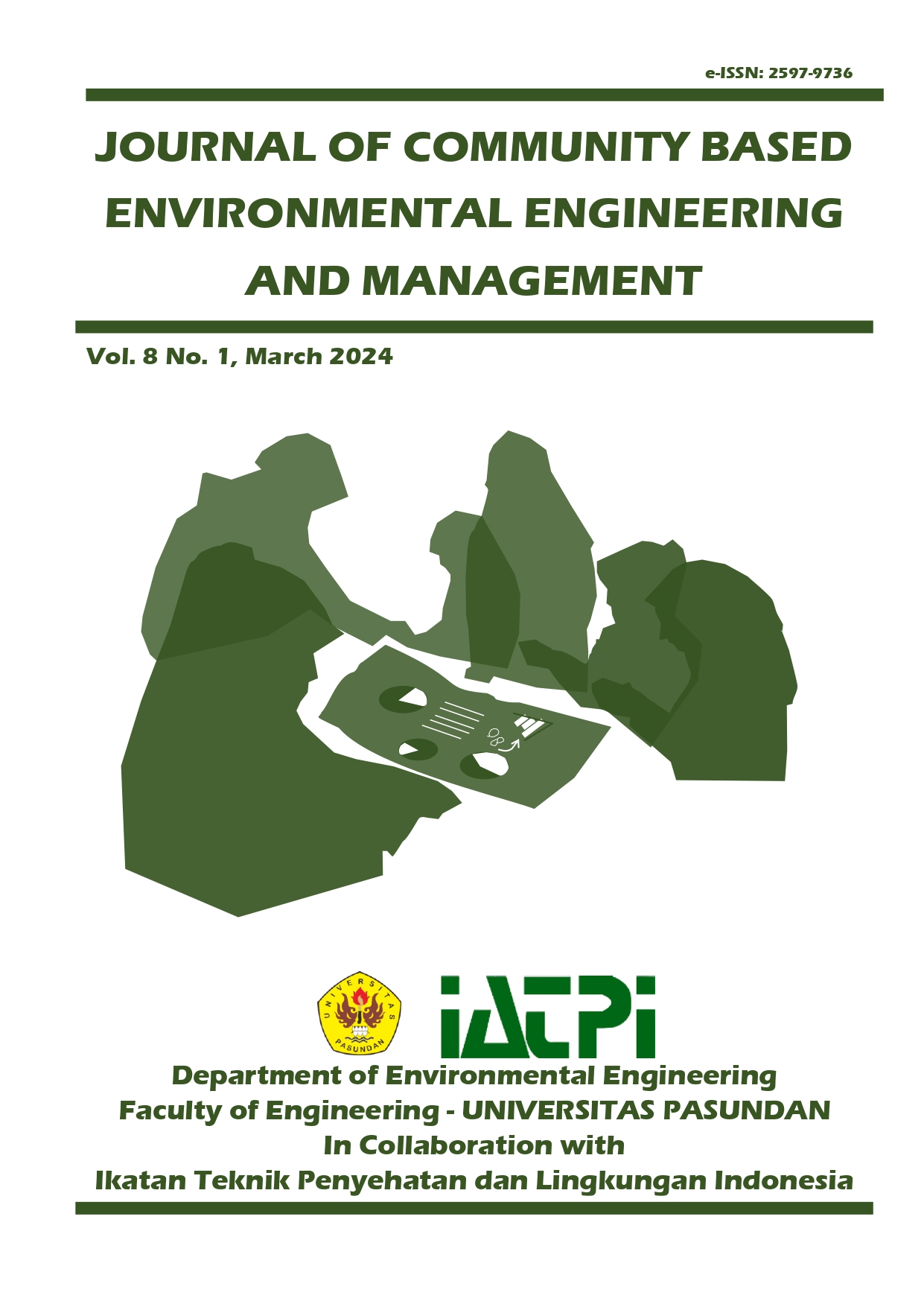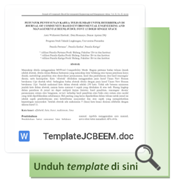The Effect of Air Flow and Stirring Frequency in Continuous Thermophilic Composting
DOI:
https://doi.org/10.23969/jcbeem.v8i1.12958Keywords:
Air hole, continous thermophilic composting, organic waste, stirring, temperatureAbstract
Continuous Thermophilic Composting (CTC) was developed as a modification of continuous composting carried out in the thermophilic phase, where the organic waste degradation process runs quickly. Previous CTC research used lamps as a heat source, which was then changed to use a heater. Several important factors in composting are stirring and air circulation to increase oxygen levels so that the aerobic composting process occurs. The machine has been modified by making air holes and setting automatic stirring. This research aims to determine the air hole openings and stirring frequency that provide the best results. The research was carried out in 2 stages. The first stage is to look for air hole openings with 3 variations: closed, half open, and fully open. Continue by finding the best stirring frequency with 3 variations: once a day, 2 times a day, and 6 times a day. The parameters measured include temperature measured humidity and pH during the composting process, and chemical analysis of fresh waste, compost starter, and mature compost resulting from the process. The research was carried out for 8 days with the addition of 1 kg of artificial waste per day. The results showed that half-open air holes produced better compost quality and temperature consistency in the thermophilic phase. And the stirring frequency of 2 times a day produces consistent temperature results in the thermophilic phase and compost quality that meets SNI 19-7030-2004 of Compost Specifications from Domestic Organic Waste.
Downloads
References
Asri, D., Ratna, P., Samudro, G., & Sumiyati, S. (2017). Pengaruh Kadar Air Terhadap Proses Pengomposan Sampah Organik dengan Metode Takakura. In Jurnal Teknik Mesin (JTM), 6(2), 124-128.
Chang, J. I., Tsai, J. J., & Wu, K. H. (2006). Thermophilic composting of food waste. Bioresource Technology, 97(1), 116-122. https://doi.org/10.1016/j.biortech.2005.02.013
Damanhuri, E. (2006). Some principal issues on municipal solid waste management in Indonesia. 1st Expert Meeting on Waste Management in Asia - Pacific Islands, Oct 27 - 29, Tokyo, 1-6
Damanhuri, E. (2008). A Future prospect of municipal solid waste management in Indonesia. Keynote Lecture in the 5th Asian-Pacific Landfill Symposium in Sapporo, Japan, Nov 22-24, 1-14
Damanhuri, E., Handoko, W., & Padmi, T. (2014). Municipal solid waste management in Indonesia. Municipal Solid Waste in Asia and the Pacific Islands, 139-155 https://doi.org/10.1007/978-981-4451-73-4_8
Elango, D., Thinakaran, N., Panneerselvam, P., & Sivanesan, S. (2009). Thermophilic composting of municipal solid waste. Applied Energy, 86(5), 663-668. https://doi.org/10.1016/j.apenergy.2008.06.009
Gill, S. S., Jana, A. M., & Shrivastav, A. (2014). Aerobic Bacterial Degradation Of Kitchen Waste : A Review. Journal of Microbiology, Biotechnology and Food Sciences, 3(6), 477483.
Hwang, E. J., Shin, H. S., & Tay, J. H. (2002). Continuous feed, on-site composting of kitchen garbage. Waste Management and Research, 20(2), 119-126. https://doi.org/ 10.1177/0734242X0202000203
Liu, K., & Price, G. W. (2011). Bioresource Technology Evaluation of three composting systems for the management of spent coffee grounds. Bioresource Technology, 102(17), 7966–7974. https://doi.org/10.1016/ j.biortech.2011.05.073
Lu, S. G., Imai, T., Li, H. F., Ukita, M., Sekine, M., & Higuchi, T. (2001). Effect of enforced aeration on in-vessel food waste composting. Environmental Technology, 22(10), 1177-1182. https://doi.org/10.1080/ 09593332208618200
Mulyatna, L., Rochaeni, A., Saputra, R., Yogi, B., & Fiqri, I. (2022). Effect of Variations in the Pretreatment of Organic Waste on The Growth of Black Soldier Flies (BSF) Larval. Journal of Community Based Environmental Engineering and Management, 6(2), 99–110. https://doi.org/ 10.23969/jcbeem.v6i2.6161
Papadopoulos, A. E., Stylianou, M. A., Michalopoulos, C. P., Moustakas, K. G., Hapeshis, K. M., Vogiatzidaki, E. E. I., & Loizidou, M. D. (2009). Performance of a new household composter during in-home testing. Waste Management, 29(1), 204–213. https://doi.org/10.1016/j.wasman. 2008.03.016
Qian, X., Sun, W., Gu, J., Wang, X. J., Zhang, Y. J., Duan, M. L., Li, H. C., & Zhang, R. R. (2016). Reducing antibiotic resistance genes, integrons, and pathogens in dairy manure by continuous thermophilic composting. Bioresource Technology, 220, 425-432. https://doi.org/10.1016/j.biortech. 2016.08.101
Rochaeni, A., Ismaria, R., & Fanira, S. (2021). Analysis of kitchen organic waste for processing using Black Soldier Flies in Kecamatan Cibiru, Bandung, West Java. IOP Conference Series: Earth and Environmental Science, 737, 012073. https://doi.org/10.1088/1755-1315/737/1/ 012073
Rochaeni, A., Mulyatna, L., Ariantara, B., Fathul, M., & Sagrim, W. M. (2021a). Continuous thermophilic composting process using heating lamps controlled by a microcontroller. IOP Conference Series: Earth and Environmental Science, 802, 012052. https://doi.org/10.1088/1755-1315/802/1/012052
Sahwan, F. L. (2016). Analisis Proses Komposting Pada Pengelolaan Sampah Berbasis Masyarakat Skala Kawasan (Studi Kasus Di Kota Depok). Jurnal Teknologi Lingkungan, 13(3), 253-260. https://doi.org/10.29122/jtl.v13i3.1394
Sahwan, F. L., Wahyono, S., & Suryanto, F. (2011). Kualitas Kompos Sampah Rumah Tangga yang Dibuat dengan Menggunakan ”Komposter” Aerobik. Jurnal Teknologi Lingkungan, 12(3), 233–240.
Schulze, K. L. (1962). Continuous thermophilic composting. Applied Microbiology, 10(2), 108-122. https://doi.org/10.1128/aem. 10.2.108-122.1962
Suler, D. J., & Finstein, M. S. (1977). Effect of temperature, aeration, and moisture on CO2 formation in bench scale, continuously thermophilic composting of solid waste. Applied and Environmental Microbiology, 33(2), 345-350. https://doi.org/10.1128/ aem.33.2.345-350.1977
Surtinah. (2013). Pengujian Kandungan Unsur Hara Dalam Kompos Yang Berasal Dari Serasah Tanaman Jagung Manis (Zea mays saccharata), Jurnal Ilmiah Pertanian, 11(1), 11-17.
Suwatanti, E., & Widiyaningrum, P. (2017). Pemanfaatan MOL Limbah Sayur pada Proses Pembuatan Kompos. Jurnal MIPA, 40(1), 1–6. http://journal.unnes.ac.id/nju/index.php/JM
Waqas, M., Almeelbi, T., & Nizami, A. S. (2018). Resource recovery of food waste through continuous thermophilic in-vessel composting. Environmental Science and Pollution Research, 25, 5212-5222. https://doi.org/10.1007/s11356-017-9358-x
Xiao, Y., Zeng, G. M., Yang, Z. H., Shi, W. J., Huang, C., Fan, C. Z., & Xu, Z. Y. (2009). Continuous thermophilic composting (CTC) for rapid biodegradation and maturation of organic municipal solid waste. Bioresource Technology, 100(2), 4807-4813. https://doi.org/10.1016/j. biortech.2009.05.013
Yustiani, Y. M., Rochaeni, A., & Aulia, E. (2019). Konsep Pengelolaan Sampah Di Desa Babakan Kabupaten Bandung. EnviroScienteae, 15(1), 121-126. https://doi.org/10.20527/es.v15i1.6332
Yustiani, Y.M. & Abror, D.F. (2019). Pengelolaan Bank Sampah Unit dala Pengelolaan Sampah Perkotaan, Jurnalis, 2(2), 82-89.














